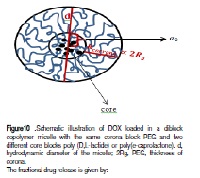n-vitro Modeling of the Release Kinetics of Micron and Nano-Sized Polymer Drug Carriers
Keywords:
Diffusion, Continuum models, Swelling, Degradation, Micelles, Molecular dynamics simulationAbstract
This article reviews in-vitro modeling of the release kinetics of hydrophobic drugs encapsulated by polymeric materials. Major continuum models along with their assumptions and limitations for micron-sized systems will be considered. The dependence on the swelling and degradation for such systems will also be discussed. As polymer micelles have gained popularity in the past decades, applications and limitations of continuum models to such nano-sized systems will be examined. A different approach based on molecular dynamics simulation will be introduced
References
. S.D.Bruck, Problems and artifacts in the
evaluation of polymeric materials for
medical uses,Biomaterials, 1 (1980)
-107.
. Y.W.Chien, B.E.Cabana,
S.E.Mares,Novel drug delivery systems:
fundamentals, developmental concepts,
biomedical assessments, M.
Dekker,14(1982) 633.
. R.Langer, Implantable controlled release
systems, Pharm Ther, (1983) 21-35.
. R.Langer, Invited Review Polymeric
Delivery Systems For Controlled Drug
Release, Chemical Engineering
Communications, 6(1980) 1-48.
. R.Langer, Medical Applications of
Controlled Release, CRC Press, FL, 2
(1986).
. G.S. Kwon, Polymeric micelles for
delivery of poorly water soluble
compounds, Drug Carrier Systems, 20
(2003) 357-403.
. M.D. Allen, A.Eisenberg, Nanoengineering block copolymer aggregates
for drug delivery, Colloids Surf., B
Biointerfaces, 16 (1999) 3-27.
.
. [8] A.Lavasanifar, G.S.Kwon,
Poly(ethylene oxide)-block-poly(-amino
acid) micelles for drug delivery, Adv
Drug Deliv Rev., 54 (2002) 169-190.
. H.A.Kataoka, Y.Nagasaki, Block
copolymer micelles for drug delivery:
design, characterization and biological
significance, Adv Drug Deliv Rev., 47
(2001) 113-131.
. S.N.H.Aerts, M.A.R.Meier, B.B.P. Staal,
M.Rasa,U.S.Schubert, Detailed
Characterization and Selected Micellar
Drug Encapsulation Behavior,
Macromolecules, 26 (2005) 1918-1924.
. A. Fick, On liquid diffusion,Membr Sci.,
(1995) 33-38.
. T. Higuchi, Rate of release of
medicaments from ointment bases
containing drugs in suspensions, Pharm
Sci., 50 (1961) 874-875.
. W.I.Higuchi, T.J. Roseman, Release of
medroxyprogesterone acetate from a
silicone polymer, Pharm Sci. , 59 (1970)
-357.
. T.J. Roseman, Release of steroids from
a silicone polymer, Pharm Sci. , 61
(1972) 46-50.
. P. Lee, Diffusional release of a solute
from a polymeric matrix-approximate
analytical solutions, Membr Sci. , 7
(1980) 255-275.
. J. Crank, The mathematics of diffusion,
Oxford University Press Inc., New York,
(1956) 1-32.
. J. Crank, The mathematics of diffusion,
Oxford University Press Inc., New York,
(1956) 1-32.
. P.S. E. D'Aurizio, L. S. Cerasa, M.
Vacca, L. Brunetti, G. Orlando, A.
Chiavaroli, R. J. Kok, W. E. Hennink,
and A. Di Stefano, Biodegradable
microspheres loaded with an antiparkinson prodrug: an in vivo
pharmacokinetic study, Mol
Pharmaceutics, 8 (6) (2011) 2408-2415.
. J. Siepmann, Modeling of diffusion
controlled drug delivery, Controlled
Release, 161 (2012) 351-362.
. G.W. Sinclair, N.A.Peppas, Analysis of
non-Fickian transport in polymers using
simplified exponential expressions,
Membr Sci., 17 (1984) 329-331.
. G.E.Alfrey,W.G.Lloyd, Diffusion in
glassy polymers, Polym Sci C., 12
(1966) 249-261.
. P.L. Ritger, N.A.Peppas,A simple
equation for decription of solute
release:Fickian and non-Fickian release
from non-swellable devices in the form
of slabs spheres,cylinders or discs,
ControlledRelease, 5 (1987) 23-26.
. R. Beker, Controlled Release of
Biologically Active Agents, John Wiley &
Sons, New York, 2(1987).
. W.C. Z. Lu, J.H.Hamman, Chitosanpolycarbophil interpolyelectrolyte
complex as a matrix former for
controlled release of poorly watersoluble drugs I in vitro evaluation, Drug
Development and Industrial Pharmacy,
(5) (2010) 539-546.
. N.A. Peppas, Analysis of Fickian and
non-Fickian drug release from polymers,
Pharm Acta Helv, 60 (1985).
. W.C. Z. Lu, J.H.Hamman, Chitosanpolycarbophil interpolyelectrolyte
. S.K. Nielsen, M. L., In Bridging time
scales: Molecular simulations for the
next decade, Berlin, Germany, 2002.
. S.L. Nielsen, C. F.; Srinivas, G.; Klein,
M. L., J. Chem. Phys., 119 (2003).
. R.L. Goetz, R. , J. Chem. Phys., 108
(1998).
. N.H. Berhane, Nyquist, C., Haghighi, K.,
Corvalan, C., Keshavarzian, A.,
Campanella, O., Rickus, J., Farhadi, A.,
A multi-scale stochastic drug release
model for polymer-coated targeted drug
delivery systems, Journal of Controlled
Release, 110 (2006) 314-322.
. S.M.D. ]. C.E. Holy, J.E. Davies, M.S.
Shoichet., In vitro degradation of a novel
poly(lactide-co-glycolide) 75/25 foam,
Biomaterials, 20 (1999) 1177ă1185.
. Encyclopedia of biopharmaceutical
statistics, Informa Health Care, New
York, 2003.
. R.C. Dutta, Rai, B., Molecular Dynamics
Study of Drug Diffusion In Hydrogels :
Effect of Cross-Linking, in: AICHE 2011.





